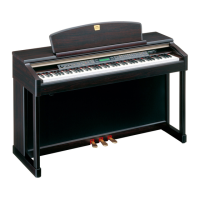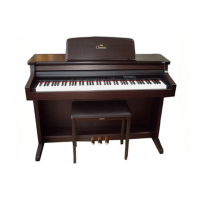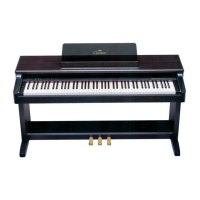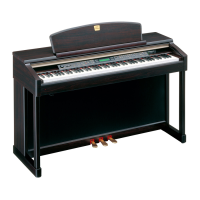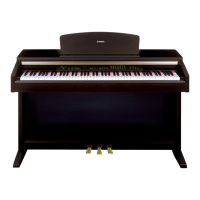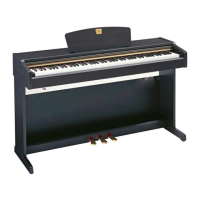Do you have a question about the Yamaha Clavinova CLP-153SG and is the answer not in the manual?
Explains safety graphics and cautions for electronic products, including symbols and their meanings.
Discusses Yamaha's commitment to environmental friendliness and provides information on product batteries.
Provides guidance on product disposal and notes on specification changes and service charges.
Indicates the location of the name plate where model, serial number, and power requirements are listed.
Covers essential precautions for using electrical products, including installation and connection safety.
Addresses warnings for wet locations, component compatibility, power cord safety, and servicing requirements.
Includes warnings about potential hearing damage and the importance of bench/fixture stability.
Highlights key features of the Clavinova, such as AWM, touch response, and dual play mode.
Urges users to read the Owner's Manual thoroughly for optimal performance and feature utilization.
Provides essential guidelines for maintaining the Clavinova's condition and appearance.
Details the operation of the POWER switch and MASTER VOLUME control for basic unit functions.
Explains the TEMPO control for metronome/recorder and the METRONOME button.
Covers selecting instrument voices and using the REVERB button for sound effects.
Describes the RECORDER [PLAY] and [REC] buttons for recording and playback operations.
Explains the DEMO button for playback and the MIDI/TRANSPOSE button for MIDI and pitch functions.
Details the functions of the pedals and instructions for operating the music stand.
Describes the AUX IN and AUX OUT jacks for connecting external audio devices or systems.
Explains the MIDI IN and OUT connectors for data transmission and control with other MIDI devices.
Details the PHONES jacks for private listening and their effect on internal speakers.
Covers turning on the power, setting volume, selecting voices, and basic playing techniques.
Instructions on how to engage, select, play, and stop the built-in demonstration tunes.
Explains how to adjust the volume balance between two voices when using Dual mode.
Details how to shift a voice up an octave in Dual mode for improved combinations.
Describes how to memorize balance and octave shift settings for recall.
Details the available reverb effect types (ROOM, HALL, COSMIC) and their sonic characteristics.
Explains how to adjust the intensity or depth of the selected reverb effects.
Describes how to memorize and retain reverb type and depth settings for future use.
Explains the four touch sensitivity settings (HARD, MEDIUM, SOFT, FIXED) for playing styles.
Describes how to memorize and retain the selected touch sensitivity setting.
Details the operation and expressive capabilities of the Soft/Sostenuto and Damper pedals.
Explains how to shift the entire keyboard's pitch up or down in semitone intervals.
Provides instructions for tuning the keyboard pitch up, down, or restoring standard pitch.
Describes how to memorize and retain the selected pitch control settings.
Details how to use the metronome, adjust its volume, and set the time signature.
Explains how to control the tempo using the panel control and specific keyboard keys.
Guides users through recording performances, playback, and fast-forwarding recordings.
Covers changing initial settings, erasing recorded data, and retaining recordings.
Provides a basic explanation of MIDI, its interface, and applications in musical systems.
Details transmitted/received MIDI messages (note, velocity, program change) and channel selection.
Explains how to transpose MIDI note data transmitted by the Clavinova.
Details how to enable/disable local control and program change reception/transmission.
Explains how to manage control change data and activate the Multi-Timbre mode.
Describes how to split the keyboard for using Clavinova and external voices simultaneously.
Instructions for transmitting recorded data to external MIDI storage devices.
Explains how to reset all settings to factory defaults and erase recorder data.
Addresses common problems like no sound, noise, interference, and distorted external audio.
Lists optional accessories such as benches, headphones, and key covers for the Clavinova.
Details the Disk Orchestra Unit expander module and its MIDI recording/playback capabilities.
Lists parts and hardware needed for assembly and instructions for opening the box.
Step-by-step instructions for attaching side panels, pedal box, and center panel.
Guidance on placing and securing the main keyboard unit onto the assembled stand.
Instructions for connecting the pedal cord and adjusting the stand's height adjuster for stability.
Details on aligning and securely fastening the main unit with screws.
Instructions for correctly connecting the pedal cable and adjusting the height adjuster.
Details various MIDI message types (Note, Control, Program Change) and their data formats.
Provides formats for Panel Data, Name Data, and Bulk Dump transmissions.
Lists key specifications including keyboard, polyphony, voices, connectivity, and dimensions.
Information on FCC compliance, warnings against unit modification, and cable connection advice.
Details Canadian noise emission limits and electrical shock prevention for plugs.
Instructions for connecting the plug and cord according to wire colors for UK mains.
| Type | Digital Piano |
|---|---|
| Number of Keys | 88 |
| Sound Engine | AWM (Advanced Wave Memory) Stereo Sampling |
| Metronome | Yes |
| Polyphony | 64 |
| Effects | Reverb, Chorus |
| Pedals | 3 (Damper, Sostenuto, Soft) |
